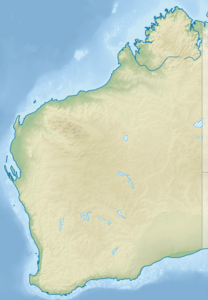Wallabi-Inseln
| Wallabi-Inseln | ||
|---|---|---|
| NASA-Landsatbild der Wallabi-Inseln. | ||
| Gewässer | Indischer Ozean | |
| Archipel | Houtman-Abrolhos-Archipel | |
| Geographische Lage | 28° 28′ S, 113° 44′ O | |
| Anzahl der Inseln | ca. 50 | |
| Hauptinsel | West Wallabi Island | |
| Gesamte Landfläche | 11,9 km² | |
| Einwohner | unbewohnt | |
| Bucht in den Wallabi-Inseln | ||
Die Wallabi-Inseln (englisch Wallabi Group) sind eine kleine Inselgruppe im Indischen Ozean, gelegen etwa 58 km vor der westaustralischen Küste. Sie bilden die nördlichste Gruppe des Houtman-Abrolhos-Archipels.
Geographie
Das Inselgebiet befindet sich 20 km nördlich der Easter Group, der zentralen Inselgruppe des Archipels, getrennt durch den Middle Channel. Es misst von Nordwest nach Südost etwa 17 km, von West nach Ost bis zu 10 km.
Die Bezeichnung Wallabi geht auf eine Gattung der kleineren Kängurus, den Wallabys zurück. Diese Tiere sind auf den beiden größten Inseln der Gruppe, West Wallabi Island und East Wallabi Island, durchaus anzutreffen.
Zu den Wallabi-Inseln gehören, neben einer Vielzahl kleinster Felsinseln, u. a. folgende Inseln:
![]() Karte mit allen Koordinaten: OSM | WikiMap
Karte mit allen Koordinaten: OSM | WikiMap
Geschichte
Im Jahre 1629 lief das niederländische Handelsschiff Batavia in den Riffen der Wallabi-Inseln, genauer: im Morning Reef etwa 1,5 km südlich vor Beacon Island, auf Grund. Der überwiegende Teil der Besatzung und der Passagiere konnte sich auf nahegelegene Inselchen retten.
Nutzung
Alle Inseln sind – mangels Trinkwasserquellen – unbewohnt. Sie dürfen zum Schutz der Fauna und Flora nur mit besonderer Genehmigung betreten werden.
Siehe auch
- Liste der Inseln im Houtman-Abrolhos-Archipel
Weblinks
- NASA-Bild (Memento vom 23. Dezember 2010 im Internet Archive) der Wallabi-Inseln in der Insel-Enzyklopädie www.oceandots.com
- (
 Karte mit allen Koordinaten: OSM | WikiMap )
Karte mit allen Koordinaten: OSM | WikiMap ) - weitere Infos & Bilder (Memento vom 16. Juli 2011 im Internet Archive) in der Insel-Enzyklopädie www.oceandots.com (englisch)
Fußnoten
- ↑ Einzelnachweise gemäß WP:BLG einfügen.
Auf dieser Seite verwendete Medien
Autor/Urheber: Tentotwo, Lizenz: CC BY-SA 3.0
Relief location map of Western Australia, Australia
Equidistant cylindrical projection, latitude of true scale 24.62° S (equivalent to equirectangular projection with N/S stretching 110 %). Geographic limits of the map:
- N: 13.2° S
- S: 35.5° S
- W: 112.5° E
- E: 129.5° E
NASA Landsat Natural Color Image of North Island and Wallabi Group, Houtman Abrolhos, Western Australia, Australia (viewed by ESRI Landsat Viewer)
Transparent red circle
Autor/Urheber: Ernie Dingo, Lizenz: CC BY-SA 2.0
This is a photograph of a beach informally known as "Cave Beach", located on one of the Wallabi Islands in the Wallabi Group of the Houtman Abrolhos.






